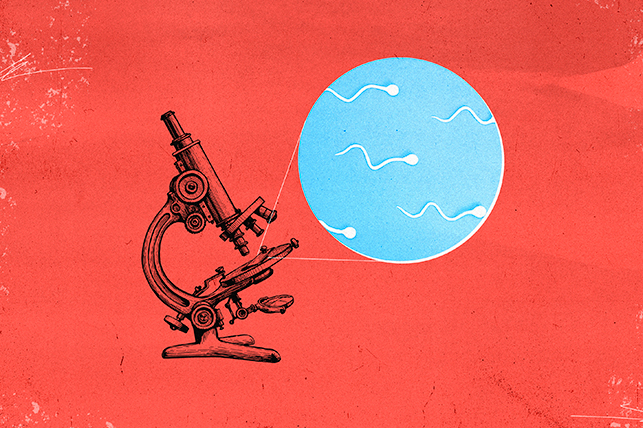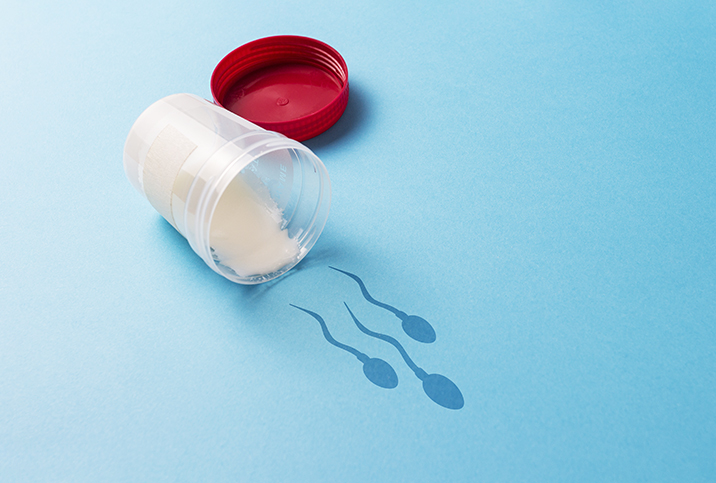How Do I Know My Semen Is Healthy?

Lots of guys might never consider the health of their semen until they're trying to conceive—or if they're worried they may have done so accidentally.
Ladies, not to shatter any illusions about that loving partner with whom you're trying to experience the magic of bringing a child into the world, but some guys consider semen less as the "miracle of life" and more like "cleanup on aisle three."
All of that changes, of course, when you're trying to conceive. Healthy semen suddenly becomes really, really important, especially if you're having difficulty getting a partner pregnant.
We present a primer on semen analysis: how it's done, who does it, what's being tested, the parameters of the test, and why someone might want to get their semen analyzed.
How is semen analysis performed?
The first thing you need for a semen analysis is, of course, semen, and we all know how that's produced. There is a way to extract sperm directly from the testicles of men who can't produce semen naturally or make enough sperm, but that usually isn't fun: It involves cutting small tissue samples from the testicle.
Best to "extract" your semen the old-fashioned way, no?
For the semen analysis, you're asked to forgo ejaculating for 24 to 72 hours beforehand, and to avoid drugs, alcohol and any hormone medications for two to five days in advance of a consultation with your healthcare provider. In the fertility specialist's office, you're sent to a dedicated room where you're given privacy—and probably some appropriate "reading material"—to produce a semen sample.
At-home semen testing kits are available on the market, but they may not be as effective as you'd hope.
"At-home kits have gained a lot of popularity the last couple of years," said Neel Parekh, M.D., a men's fertility and sexual health specialist with Cleveland Clinic. "Those kits do not give you all the same reference values and information as a typical semen analysis. But it's oftentimes useful because they get a baseline or get guys in the door to realize there's a problem, or because they live far away and don't have access to a lab nearby."
Some men are embarrassed about the whole situation of having to ejaculate into a cup in an office and carry a specimen around, he added.
If you do opt to use an at-home test, be aware that they usually only look at sperm concentration. There are a number of other values fertility experts analyze, including the following:
- Semen volume. Significantly less than 1.5 milliliters (mL) of total semen may indicate a blockage or other issue.
- Sperm concentration (or sperm count). A count of 15 million to 300 million sperm per mL or higher is considered normal.
- Total number of sperm. The World Health Organization states 39 million sperm per ejaculation is normal.
- Morphology. The size and shape of the sperm are analyzed.
- Motility. Analysts measure the ability of the sperm to move.
- Semen pH. The acidity of the semen is crucial to its ability to survive long enough to fertilize an egg.
- Signs of infection.
"A lot of guys get hung up on the volume, the color, the smell—these are a lot of the things that bother guys," Parekh said. "The volume, obviously, if it's very low, it could be a sign of something else, but normal volume is 1.5 mL. So we look at the amount of fluid, and if it's very low, that could be an indication of a blockage or a retrograde ejaculation; that's where the semen is traveling backward, not forward."
It's important to note that there is a lot of normal variation in not only semen volume but also in color. It can range from very white to yellowish to a gray color, depending on your diet, how hydrated you are and how long it's been since you last ejaculated.
If you consistently notice a foul odor, however, or a brownish/reddish color, that may be a sign of infection or a condition called hematospermia, or blood in the semen, and you should get checked by a doctor.
Who conducts the semen analysis?
The other advantage of getting a semen analysis done in a clinical setting, besides the array of parameters analyzed, is the level of expertise and human judgment. You're not counting on the results of a test you bought on Amazon to provide a thumbs-up on one of your most important life events.
"Most often, it's done in a lab by an andrologist or a lab technician in an andrology lab," Parekh said. "So they're all certified and trained, and they have quality metrics that they adhere to. The most common semen analysis is done usually manually, so they have counting chambers. They're not looking at every single square inch of the specimen; they're looking at a small portion and extrapolating that information to get the results."
Why get a semen analysis?
Beyond the obvious, there are a few other situations that call for a semen analysis.
Vasectomy follow-up
Guys who have a vasectomy need to go back for semen analysis to make sure the procedure was successful. The first semen analysis following a vasectomy is appropriate between eight and 16 weeks after the procedure, according to the guidelines from the American Urological Association (AUA).
Other societies and expert groups say men should have 20 ejaculations following the procedure as another benchmark for when to get tested.
Just FYI: The AUA says fewer than 1 percent of vasectomy procedures fail.
Upcoming cancer treatment
Some cancer treatments can affect a man's fertility. Before starting treatment, most healthcare providers recommend testing, especially if you plan on banking sperm.
"Other reasons you might get it done is prior to any sort of cancer treatment," Parekh explained. "If someone's going to be having radiation or chemo for many types of cancer, that can often render them sterile or reduce their sperm count. It's often recommended to get a semen analysis when you're going to be saving sperm due to any kind of cancer treatment or surgery."
Varicoceles
Varicoceles are a relatively common condition in which the veins in the testicle become enlarged. They're often left untreated, but sometimes they can affect sperm production.
"They're very common; 15 percent of the population have them," Parekh said. "And if they're significant, varicocele grade 2 or grade 3, and patients are on the fence about getting it fixed or not, in those cases, if the semen analysis is abnormal, that's more of a reason to fix the varicocele sooner rather than later."
You might need to just do it
While the idea of producing a semen sample for testing might be a reliable way to get a chuckle at a comedy show, the fact of the matter is guys are lucky. It's comparatively much easier for males to get their fertility tested than it is for females, despite the potential embarrassment of what happens in that room.
It may make sense to perform a preliminary test using an at-home kit, but know that getting a professional semen analysis can tell you so much more. If there is a problem, it can even provide a road map for you and your healthcare provider to figure out how to help you conceive.


















